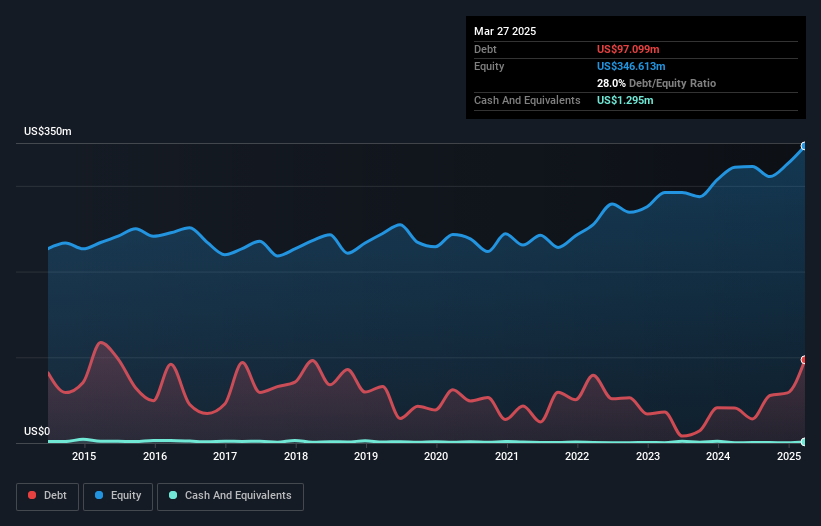
Legendary fund manager Li Lu (who Charlie Munger backed) once said, 'The biggest investment risk is not the volatility of prices, but whether you will suffer a permanent loss of capital.' It's only natural to consider a company's balance sheet when you examine how risky it is, since debt is often involved when a business collapses. We can see that John B. Sanfilippo & Son, Inc. (NASDAQ:JBSS) does use debt in its business. But the more important question is: how much risk is that debt creating?
We've discovered 1 warning sign about John B. Sanfilippo & Son. View them for free.What Risk Does Debt Bring?
Debt is a tool to help businesses grow, but if a business is incapable of paying off its lenders, then it exists at their mercy. If things get really bad, the lenders can take control of the business. However, a more usual (but still expensive) situation is where a company must dilute shareholders at a cheap share price simply to get debt under control. Of course, debt can be an important tool in businesses, particularly capital heavy businesses. When we examine debt levels, we first consider both cash and debt levels, together.
What Is John B. Sanfilippo & Son's Debt?
The image below, which you can click on for greater detail, shows that at March 2025 John B. Sanfilippo & Son had debt of US$97.1m, up from US$40.7m in one year. Net debt is about the same, since the it doesn't have much cash.

How Healthy Is John B. Sanfilippo & Son's Balance Sheet?
We can see from the most recent balance sheet that John B. Sanfilippo & Son had liabilities of US$174.0m falling due within a year, and liabilities of US$69.4m due beyond that. Offsetting these obligations, it had cash of US$1.30m as well as receivables valued at US$74.5m due within 12 months. So it has liabilities totalling US$167.5m more than its cash and near-term receivables, combined.
This deficit isn't so bad because John B. Sanfilippo & Son is worth US$779.3m, and thus could probably raise enough capital to shore up its balance sheet, if the need arose. However, it is still worthwhile taking a close look at its ability to pay off debt.
Check out our latest analysis for John B. Sanfilippo & Son
We use two main ratios to inform us about debt levels relative to earnings. The first is net debt divided by earnings before interest, tax, depreciation, and amortization (EBITDA), while the second is how many times its earnings before interest and tax (EBIT) covers its interest expense (or its interest cover, for short). This way, we consider both the absolute quantum of the debt, as well as the interest rates paid on it.
John B. Sanfilippo & Son's net debt is only 0.93 times its EBITDA. And its EBIT covers its interest expense a whopping 27.2 times over. So you could argue it is no more threatened by its debt than an elephant is by a mouse. But the bad news is that John B. Sanfilippo & Son has seen its EBIT plunge 12% in the last twelve months. If that rate of decline in earnings continues, the company could find itself in a tight spot. The balance sheet is clearly the area to focus on when you are analysing debt. But you can't view debt in total isolation; since John B. Sanfilippo & Son will need earnings to service that debt. So if you're keen to discover more about its earnings, it might be worth checking out this graph of its long term earnings trend.
But our final consideration is also important, because a company cannot pay debt with paper profits; it needs cold hard cash. So we clearly need to look at whether that EBIT is leading to corresponding free cash flow. During the last three years, John B. Sanfilippo & Son produced sturdy free cash flow equating to 63% of its EBIT, about what we'd expect. This cold hard cash means it can reduce its debt when it wants to.
Our View
When it comes to the balance sheet, the standout positive for John B. Sanfilippo & Son was the fact that it seems able to cover its interest expense with its EBIT confidently. But the other factors we noted above weren't so encouraging. For instance it seems like it has to struggle a bit to grow its EBIT. Considering this range of data points, we think John B. Sanfilippo & Son is in a good position to manage its debt levels. But a word of caution: we think debt levels are high enough to justify ongoing monitoring. The balance sheet is clearly the area to focus on when you are analysing debt. But ultimately, every company can contain risks that exist outside of the balance sheet. To that end, you should be aware of the 1 warning sign we've spotted with John B. Sanfilippo & Son .
Of course, if you're the type of investor who prefers buying stocks without the burden of debt, then don't hesitate to discover our exclusive list of net cash growth stocks, today.
Have feedback on this article? Concerned about the content? Get in touch with us directly. Alternatively, email editorial-team (at) simplywallst.com.
This article by Simply Wall St is general in nature. We provide commentary based on historical data and analyst forecasts only using an unbiased methodology and our articles are not intended to be financial advice. It does not constitute a recommendation to buy or sell any stock, and does not take account of your objectives, or your financial situation. We aim to bring you long-term focused analysis driven by fundamental data. Note that our analysis may not factor in the latest price-sensitive company announcements or qualitative material. Simply Wall St has no position in any stocks mentioned.